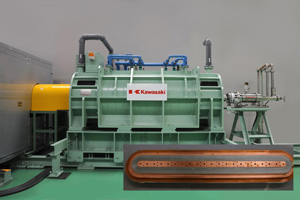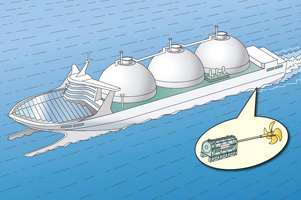New Megawatt Superconducting Motor Tops Japanese Output Record
Nov. 01, 2010
 |
 |
Superconducting motor prototype(with superconducting coil at bottom right) |
Future use with a hydrogen carrier |
Tokyo, November 1, 2010 — Kawasaki Heavy Industries, Ltd. announced today that its prototype superconducting motor has broken a new record. The motor achieved Japan’s highest power output of 450 kW in a test conducted at Kawasaki’s Akashi Technical Institute in Akashi, Hyogo Prefecture. This achievement marks yet another breakthrough in Kawasaki’s research and development into space and energy-saving superconducting motors for large vessel propulsion systems as well as large-scale industrial drive systems.
1.About the Breakthrough
Superconductivity is a unique phenomenon that has been observed in specific materials. When these materials are cooled to ultralow temperatures, they demonstrate absolutely no electrical resistance. If applied to various devices and systems, this phenomenon can significantly boost efficiency.
Superconducting coils incorporated into the design of the prototype motor’s rotor are cooled with cryogenic gas. Eliminating the need for an iron core to generate a strong magnetic field, these coils have enabled Kawasaki to build a motor that's half the size of conventional models. This most recent test was conducted on a prototype motor with a designed output of 1 MW. When two out of six coils were installed on each pole, the motor’s power output reached 450 kW with an outstanding efficiency rate* of 98% to top the Japanese record. The test results suggest that motor output will reach 1 MW when all coils are installed.
*Motor efficiency is the ratio of mechanical energy output to electrical energy input.
2.Possible Applications
While ships are now starting to employ electric propulsion systems designed to reduce environmental load and diversify energy sources, the maritime industry is still looking for new ways to boost fuel efficiency as well as cut emissions in order to combat climate change even further. It’s against this backdrop that superconducting technology has fallen under the spotlight as a sustainable solution to the world’s mounting energy and environmental problems.
A vessel employing an electric propulsion system with a superconducting motor will consume far less electricity than an ordinary diesel engine ship. What’s more, the motor’s compact size makes room for optimal hull designs that will reduce wave resistance. Another benefit is minimal energy loss since the motor drives the ship’s propellers directly without the use of speed reducers. Altogether these advantages of superconducting technology cut fuel consumption by about 20%.
This year, Kawasaki began development of a 3 MW commercial model for use with various types of domestic cargo vessels that will boast the world’s highest efficiency and smallest footprint. Kawasaki is moving full speed ahead to put superconducting motors to use on medium and large-sized merchant ships as well as industrial power generators and drive systems for highly efficient products designed to shrink our carbon footprint. Superconducting motors for liquefied natural gas carriers as well as tomorrow’s liquefied hydrogen carriers are making the most of cold energy to bring propulsion system efficiency to new heights.
Kawasaki has been developing a superconducting motor under a project commissioned (and currently subsidized) by the New Energy and Industrial Technology Development Organization (NEDO) since September 2007 in cooperation with the Tokyo University of Marine Science and Technology, the National Maritime Research Institute, Japan Superconductivity Organization, and Sumitomo Electric Industries, Ltd.





